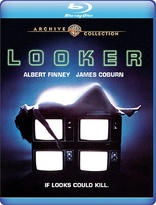Looker Blu-ray Movie
HomeLooker Blu-ray Movie 
Warner Archive CollectionWarner Bros. | 1981 | 93 min | Rated PG | Sep 18, 2018
Movie rating
6.4 | / 10 |
Blu-ray rating
| Users | 3.5 | |
| Reviewer | 3.5 | |
| Overall | 3.5 |
Overview
Looker (1981)
Plastic surgeon Larry Roberts performs a series of minor alterations on a group of models who are seeking perfection. The operations are a resounding success. But when someone starts killing his beautiful patients, Dr. Roberts becomes suspicious and starts investigating. What he uncovers are the mysterious - and perhaps murderous - activities of a high-tech computer company called Digital Matrix.
Starring: Albert Finney, James Coburn, Susan Dey, Leigh Taylor-Young, Dorian HarewoodDirector: Michael Crichton
| Thriller | Uncertain |
| Sci-Fi | Uncertain |
| Crime | Uncertain |
| Drama | Uncertain |
| Action | Uncertain |
Specifications
Video
Video codec: MPEG-4 AVC
Video resolution: 1080p
Aspect ratio: 2.40:1
Original aspect ratio: 2.39:1
Audio
English: DTS-HD Master Audio 2.0 (48kHz, 24-bit)
Subtitles
English SDH
Discs
Blu-ray Disc
Single disc (1 BD)
Playback
Region free
Review
Rating summary
| Movie | 2.5 | |
| Video | 4.0 | |
| Audio | 4.0 | |
| Extras | 4.0 | |
| Overall | 3.5 |
Looker Blu-ray Movie Review
Keep Looking
Reviewed by Michael Reuben September 20, 2018Today it's routine to scan an actor from head to toe for a digital simulation that can be
realistically placed in a movie, either on its own or superimposed over a stunt double. Digital
characters created through motion capture give performances touted for Oscar nominations (see,
e.g., Andy Serkis in War
for the Planet of the
Apes).
But who was thinking of such things in the early Eighties? The late Michael Crichton was. The same
futuristic imagination that put cyborgs onscreen in Westworld, envisioned a computer-controlled warehouse for comatose patients in Coma
and foresaw the
dangerous potential of genetic manipulation in
Jurassic Park
also created the first
all-digital human simulation on film in Looker, which was
released in 1981—long before Intel, Apple and IBM had transformed computing into the daily
tool we take for granted today. When Crichton wrote and directed Looker, computers were still refrigerator-sized
behemoths, requiring
huge rooms and fleets of technicians to manage their whirring tapes
and desk-size terminals. The film's depiction of technology is hopelessly dated, but as usual with
Crichton, his instincts about where we were heading were uncannily accurate.
The Warner Archive Collection is adding Looker to its catalog in a new transfer, and WAC has
included all of the extras from the 2007 DVD, plus an important new one. For theatrical release,
Crichton removed an entire sequence from the middle of the film that fills in a few plot holes
(though plenty remain). Until now, that sequence has only been seen on network TV broadcasts,
and if nothing else, it's an interesting example of the hard choices that have to be made in the
editing room.
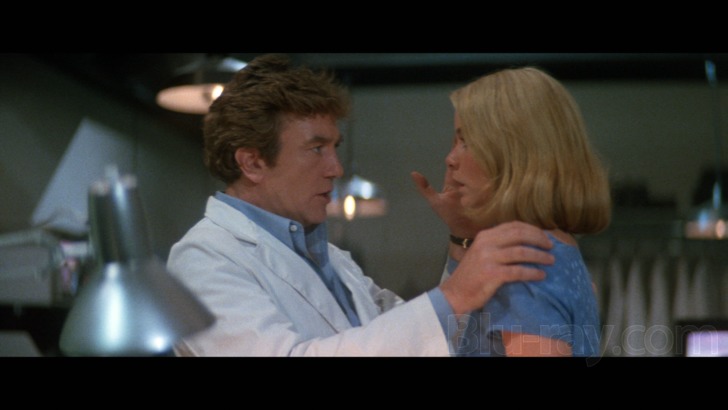
Looker takes the form of a murder investigation, and the unlikely detective is a Beverly Hills plastic surgeon, Dr. Larry Roberts (Albert Finney). The doctor is perplexed by a string of young female patients who are already drop-dead gorgeous but engage his services in order to be made "perfect". All of them arrive with a list of cosmetic adjustments specified to the millimeter. Though dubious, Roberts performs the surgeries and sends the ladies on their way. When those patients start turning up dead, apparently through accidents or suicide, clues planted at the scene suggest the doctor's involvement. But they're such obvious plants that even the LAPD detective investigating the cases (Dorian Harewood) doesn't accept them at face value.
Concerned for the safety of his latest "perfect" patient, Cindy Fairmont (Susan Dey, everyone's beloved Laurie from The Partridge Family), Roberts begins to investigate, seemingly abandoning the lucrative medical practice that has allowed him to acquire a comfy beachfront home in Malibu. The trail quickly leads to a company called Digital Matrix, a purported research facility owned by Reston Industries. CEO John Reston (James Coburn) is an expansive, charismatic figure who seems to have his fingers into everything, including a rising political star with presidential ambitions, Senator Harrison (Michael Hawkins). Publicly, of course, Reston is a pillar of the community, but privately he's plotting world domination, supported by his loyal assistant, Jennifer (Leigh Taylor-Young), and a silent henchman (Tim Rossovich) who neither speaks nor has a name (the credits identify him only as "Moustache Man", for reasons that should be obvious from the screenshots).
Reston's scheme involves targeted TV advertising, much of it using the "perfect" models created by Dr. Roberts. Digital Matrix plans to embed subliminal hypnotic pulses into the ads designed to guide consumer choices, including their electoral votes. The company's mind control research has also produced a unique "gun" that fires pulses of light, placing people into a temporary hypnotic state that allows Moustache Man to complete whatever task Reston has assigned him, whether it's killing off the perfect models or ransacking Dr. Roberts' home. The "gun" is known as "LOOKER", which stands for "Light Ocular-Oriented Kinetic Emotive Responses". As should be obvious, the acronym has been engineered to give the film's title its double meaning.
I have a soft spot in my heart for Looker, but I would never contend that it's a good film. The plot is ridiculous. We're supposed to accept John Reston as an evil genius, except that he's the dumbest one in history. He spends the entire film sabotaging his own secret plan. Killing off the models accomplishes nothing except drawing attention to a project that depends on secrecy for its success. (The explanation provided in the deleted sequence is thinner than tissue paper.) Once the suspicions of Dr. Roberts are aroused, Reston doesn't take the obvious step of sealing up Digital Matrix to protect corporate secrets. Instead, he lets Jennifer invite Roberts on an extensive tour, where she specifically identifies the LOOKER lab as the only area that's off-limits. (Why not just paint a bull's-eye on the door?) Despite its importance, the lab's security is so lax that a child could penetrate it, which Roberts and Cindy do later that night. Then, as Roberts gets closer to the truth, Reston allows his moustached henchman to wreck havoc on the streets of L.A., while lesser hired thugs shoot up the doctor's office, thereby further attracting police attention and undercutting the original effort to frame Roberts for his patients' murders. Even James Coburn's considerable screen charisma is eventually overcome by the stupidity of his character. By the time we reach the film's finale, where Reston grabs a pistol and begins shooting up the demonstration for industry movers and shakers that he's previously fretted is the most important gathering in the company's history, the character is more joke than villain. (In fairness to the writer/director, I should note that he considers the film a comedy.)
Crichton was a good storyteller, and he must have known that his plot didn't add up, but he was no doubt counting on Looker's depiction of then-revolutionary technological advances to power over the narrative obstacles. It didn't work then—the film was a critical and box office failure—and it still doesn't, especially now that the technology is positively antique. But Finney and Dey are charming in their roles, and Crichton's depiction of the LOOKER gun's effects are inventive, especially given the limitations of pre-digital effects. For all its shortcomings, the film is full of eerie portents about the future, as Crichton's work usually was. In the scene where Cindy visits her parents, and neither of them can tear their eyes from the TV screen, all you have to do is substitute smart phones for television, and suddenly Looker seems oddly prescient. So does the notion of directing voter choices through mass media, except that today it's done on the internet and social media, and the effort has gone global.
Looker Blu-ray Movie, Video Quality 
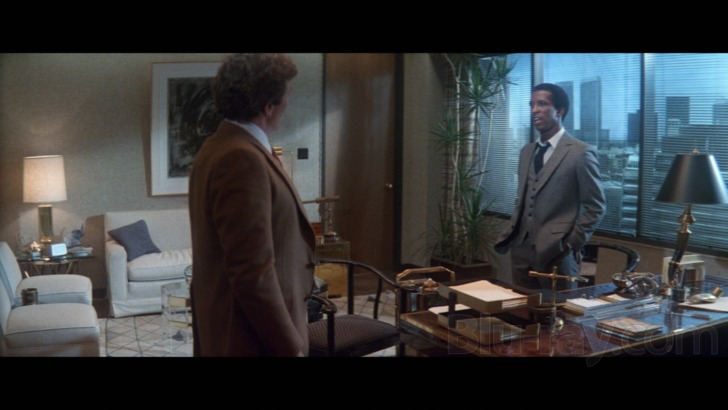
Looker was shot by Paul Lohmann (Time
After Time and
Nashville), who gave much of the
film's imagery a cold, high-tech sheen favoring blues, whites and grays. For this 1080p, AVC-encoded Blu-ray, the Warner
Archive Collection
commissioned a new scan of a production-era
interpositive, which was performed by Warner's MPI facility at 2K. MPI used production stills as
a reference for color correction, and they also consulted the TV video master from which the deleted sequence
in the extras was taken, because that master was prepared with the director's participation. WAC
subjected the newly created master to its usual thorough frame-by-frame cleaning to eliminate
dirt, scratches and age-related damage.
Looker is a grainy film, and the grain is fully on display in this new Blu-ray, but it moves
naturally throughout and does not exhibit any evidence of untoward digital tampering. If you
focus on the image rather than the grain, it's immediately obvious that the new scan has picked
up substantial detail in sets, locations, costumes and faces, and while the picture may lack the
crispy sharpness of digital photography, its inherent softness doesn't detract from the overall
clarity. (Screen captures don't do it justice.) Colors can be brilliant, like the glowing green
checkerboard lines on the giant floor where the film's finale plays out, or softly muted, like Dr.
Roberts' conservative wardrobe. Blacks are generally deep, although there are a few occasions
when they shift slightly to dark grey; these shifts may well be source-related.
WAC has given Looker its usual careful authoring, with a high average bitrate of 34.99 Mbps,
which is particularly valuable with a grainy image. My video score reflects appreciation for
WAC's effort to preserve Looker's original look. Viewers who object to prominent grain will
find the score too high, which is their prerogative, but I give WAC credit for refraining from any
attempt to modify the image for eyes conditioned by contemporary digital smoothness.
Looker Blu-ray Movie, Audio Quality 
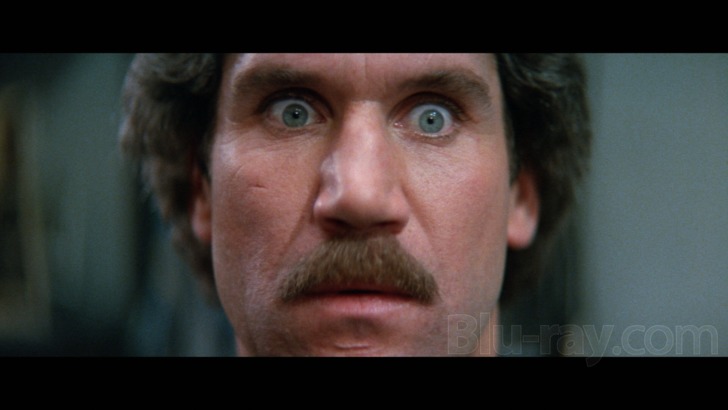
Looker was released in Dolby Surround, and WAC has taken the mix from the 35mm magnetic
Dolby stereo printmaster and encoded it as lossless DTS-HD MA 2.0. When played back through
a surround decoder, the track creates a quietly enveloping sense of environmental ambiance,
while most of the action remains in the front. An occasional key sound effect projects outward
into the listening space, notably the impact of the LOOKER gun when it scores a "hit" on its
target, creating a "whoosh" that expands toward the back of the room. (When the shooter doesn't connect with the
victim's eyes, the "whoosh" stays in front.) The regular gunfire from the attackers in Dr. Roberts'
office doesn't have nearly the sonic oomph you would find on a contemporary track, but it gets
the job done, especially when accompanied by the high-pitched tinkle of breaking glass.
Dialogue is clear and remains clearly anchored to the center.
Looker has a memorable electronic soundtrack by Barry De Vorzon (The Warriors), who, as the
director notes in his commentary, wasn't afraid to repeat the same cue numerous times, creating a
haunting effect that contributes much of whatever suspense the film is able to sustain. The great
title song was written by De Vorzon and Mike Towers and performed by the new wave band Sue
Saad and the Next. (Kim Carnes later recorded her own version, but her vocals are warmer and
more passionate; Saad's chilly tones are better suited to the film.)
Looker Blu-ray Movie, Special Features and Extras 
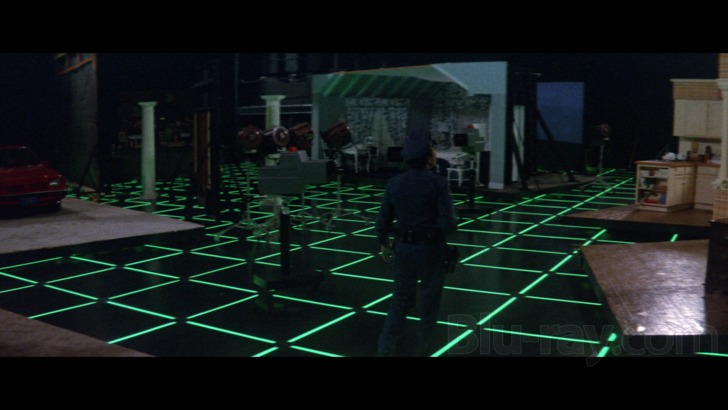
- Commentary by Michael Crichton: Recorded for the 2007 DVD release, Crichton routinely sounds bemused at the many elements of Looker that were novel when he made it but are now routine (including plastic surgery, which, as he points out, people used to undergo in secret and pretend they hadn't done). He describes working with a cast of actors from radically different backgrounds, on both this film and others, and points out numerous tricks that have now been superseded by green screen and CG replacement. Whether deliberately or not, he carefully avoids addressing the plot's many problems and improbabilities, preferring to focus on technical and logistical challenges.
- Introduction by Michael Crichton (480i; 1.85:1; 4:43): This video clip plays like an extension of the commentary, with Crichton situating the film in his career, describing how the project arose, and highlighting the challenge of balancing the movie's technical and human elements.
- Deleted Scene (As Used in Network Television Version) (480i; 1.33:1; 8:14): This
extended sequence would have occurred immediately after Dr. Roberts and Cindy have
snuck into Digital Matrix at night, discovered the LOOKER gun and evaded Moustache Man. (Mild spoilers ahead.)
Instead of escaping immediately, they are captured by Reston's men and held captive at the CEO's home just
long enough for Reston to give the classic villain's speech in which he outlines his evil
plan, explaining why the "perfect" girls had to be killed and how Roberts will be blamed
for their deaths after his apparent "suicide". Then Reston returns to a fundraiser he's
holding for Senator Harrison, where the Senator is busily outlining his pro-corporate
agenda. Meanwhile, Roberts and Cindy narrowly escape by crawling out an upstairs
windows and across a glass gazebo.
When the film was assembled, this lengthy scene no doubt was found to slow it down at a critical point and was therefore dropped. Unfortunately, some useful exposition went with it.
Note that the image is squeezed, indicating that the full width of the anamorphic frame has been included in this insert. I never saw Looker on network TV but have been advised by WAC that the entire film was presented this way on the video master, which was prepared with Crichton's participation. Perhaps the director elected to accept the distorted geometry as a lesser evil than cropping the frame. - Theatrical Trailer (1080p; 1.78:1; 1.33:1): "Hi, I'm Cindy. I'm the perfect female type."
Looker Blu-ray Movie, Overall Score and Recommendation 
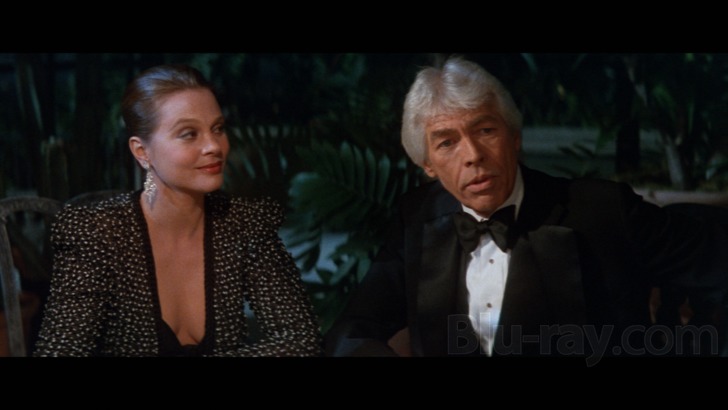
Crichton made better films than Looker, including Coma, The Great Train Robbery, Runaway and the original Westworld. His imagination also
gave us the world of Jurassic
Park and
its
ongoing sequels. Looker ranks among his lesser efforts, but it's still a lot of
fun, even at its
silliest. It also reflects Crichton's remarkable instinct for what the future might hold. Even if events
didn't play out exactly as he imagined, Crichton saw the broad outlines of what was coming.
WAC's Blu-ray presentation is superior and recommended, especially with the
expanded extras.
Similar titles
Similar titles you might also like

The Manhattan Project
1986

Escape from New York 4K
Collector's Edition
1981

Shadows in an Empty Room
Blazing Magnum / Una Magnum Special per Tony Saitta
1976

The Warriors 4K
Standard Edition
1979

The Ape Man
1943

Missing
2023

The Stone Killer
Limited Edition to 3000
1973

Upgrade 4K
2018

Black Moon Rising
1986

The Alphabet Killer
2008

Dark Crimes
2016

Exterminator 2
1984

The Final Option
Who Dares Wins
1982

Judgment Night
Warner Archive Collection
1993

Death Wish 3 4K
1985

F/X
1986

Live Like a Cop, Die Like a Man
4K Restoration
1976

Night of the Juggler 4K
1980

Elsewhere
2009

Silk Road
2021
